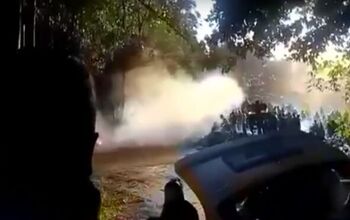EVs Deadly After They Crashed

While EVs are slowly, very slowly – catching on would be exaggerated, people are starting to think about the finer points. For instance: Electric vehicles and plug-in hybrids are powered by high-voltage batteries of up to 400 volts, possibly more. What happens if one crashes and first responders have to attack the vehicle with power cutters? Will the responder die from electrical shock? This is a hot topic amongst first responders, right up there with dealing with explosive airbags, belt tensioners and other surprises.
Currently, each manufacturer publishes an individual Emergency Response Guide that tells them where to cut and where not. Easy to forget, especially with the paucity of EVs on the roads.
German automotive supplier Continental has developed a sensor unit for electric and plug-in hybrid vehicles which will immediately shut off the high-voltage battery in the event of a collision. Well, not exactly:
“The evSAT acceleration sensor is active in charge mode. It detects an accident and passes this information on to the battery management system which then shuts off the high-voltage battery,” Ibtimes was told by Dr. Axel Gesell, Senior Manager Platform Development Sensors & Satellites of Continental’s Chassis & Safety Division. “The major benefit of our product is that it prevents fire and rescue service personnel sustaining high-voltage injuries when coming into contact with vehicle metal parts or if they have to cut through the vehicle to recover accident victims.”
But what if the battery management system is dead already? And how do you know that the power is on or off? Current manufacturers of EVs have similar systems, one way or the other. None are perfect. According to greencarreports, automakers all tend to give variations of the same answer: “We’ve followed all the usual design standards on this new vehicle, and we’ll be offering training to national responder organizations that is disseminated down to their various members.”
One thing is for sure: EMS personnel will approach crashed EVs very carefully. Which may provide a niche for a certain market segment: Drug dealers. Police officers will search an EV with great caution. They are being trained not to pry apart the metal battery casing for the high-voltage battery, and not to mess with the battery itself. I will leave the rest as an exercise to the student.

Bertel Schmitt comes back to journalism after taking a 35 year break in advertising and marketing. He ran and owned advertising agencies in Duesseldorf, Germany, and New York City. Volkswagen A.G. was Bertel's most important corporate account. Schmitt's advertising and marketing career touched many corners of the industry with a special focus on automotive products and services. Since 2004, he lives in Japan and China with his wife <a href="http://www.tomokoandbertel.com"> Tomoko </a>. Bertel Schmitt is a founding board member of the <a href="http://www.offshoresuperseries.com"> Offshore Super Series </a>, an American offshore powerboat racing organization. He is co-owner of the racing team Typhoon.
More by Bertel Schmitt
Latest Car Reviews
Read moreLatest Product Reviews
Read moreRecent Comments
- Master Baiter Mass adoption of EVs will require:[list=1][*]400 miles of legitimate range at 80 MPH at 100°F with the AC on, or at -10°F with the cabin heated to 72°F. [/*][*]Wide availability of 500+ kW fast chargers that are working and available even on busy holidays, along interstates where people drive on road trips. [/*][*]Wide availability of level 2 chargers at apartments and on-street in urban settings where people park on the street. [/*][*]Comparable purchase price to ICE vehicle. [/*][/list=1]
- Master Baiter Another bro-dozer soon to be terrorizing suburban streets near you...
- Wolfwagen NO. Im not looking to own an EV until:1. Charge times from 25% - 100% are equal to what it takes to fill up an ICE vehicle and 2. until the USA proves we have enough power supply so as not to risk the entire grid going down when millions of people come home from work and plug their vehicles in the middle of a heat wave with feel-like temps over 100.
- Kwik_Shift_Pro4X Where's the mpg?
- Grg These days, it is not only EVs that could be more affordable. All cars are becoming less affordable.When you look at the complexity of ICE cars vs EVs, you cannot help. but wonder if affordability will flip to EVs?

































Comments
Join the conversation
AP Columbia. 9AM GMT. Columbian drug lords just placed an order for 1,000 Toyota Prius Hybrid vehicles. A source who wishes to remain anonymous... er, now dead, said that the idea that they could carefully pry apart the batteries to pack illegal drugs in them was a brilliant idea of Americans who have told their law enforcement officials NOT to inspect EV vehicles in fear of being electrocuted. Another anonymous...er, dead too, source told AP that they will be using the Toyota Prius as drug mules exclusively, with old people driving them, so as to not draw attention to the vehicles going in and out of Mexico, packed with cocaine, heroin and marijuana. When asked, one of the drug lords said this: The Americans are dumb so we plan on buying the first 5,000 Chevy Volts to be used as our preferred method of mule transport, that way the idiot law enforcement people won't dare tear apart a UAW made car in fear or reprisals from the Unions in America. A GM spokesperson could not be reached for comment, but a local Chevy dealer said this: We sell to all qualified buyers, even if they bring in cash that's a little dusty with white powder. As long as it's cold-hard American dollars, we will sell, sell, sell! (ok, the above is a spoof, so don't get your panties all in a bunch!)
There was much hand wringing about this with early hybrids - it hasn't panned out to be a real problem. As a former EMT the first rule is - don't become a victim yourself, assess the situation and proceed when it is known to be safe.